The barbell deadlift is the king of the jungle when it comes to pulling exercises. It’s a primary movement with the potential to move the most weight. Plus, it’s a competition lift in powerlifting, along with the back squat and bench press. The classic deadlift will always be popular.
But if you’re looking for a deadlift variation that’s easier on the spine, builds muscle in your upper and lower body, improves posture, and helps to boost your barbell deadlift, trade the bar for a pair of dumbbells.
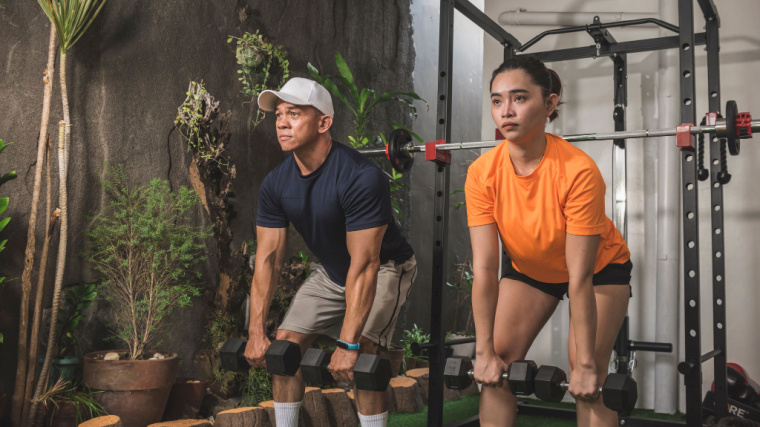
The dumbbell deadlift is an overlooked exercise that can increase muscle and strength while providing less compressive load on your spine. It allows you to train the same movement pattern with reduced lower back strain compared to the barbell exercise.
Here’s a closer look at the dumbbell deadlift including how and why it’s done, what not to do, programming tips, and more. mistakes to avoid. It’s time to be reminded why “the deadlift” is not all about the barbell.
- How to Do the Dumbbell Deadlift
- Dumbbell Deadlift Mistakes to Avoid
- How to Progress the Dumbbell Deadlift
- Benefits of the Dumbbell Deadlift
- Muscles Worked by the Dumbbell Deadlift
- How to Program the Dumbbell Deadlift
- Dumbbell Deadlift Variations
- Frequently Asked Questions
How to Do the Dumbbell Deadlift
Here’s a step-by-step guide for performing the dumbbell deadlift with safe and effective technique. This movement is performed “suitcase-style” with a pair of dumbbells by your sides.
Step 1 — Nail the Setup
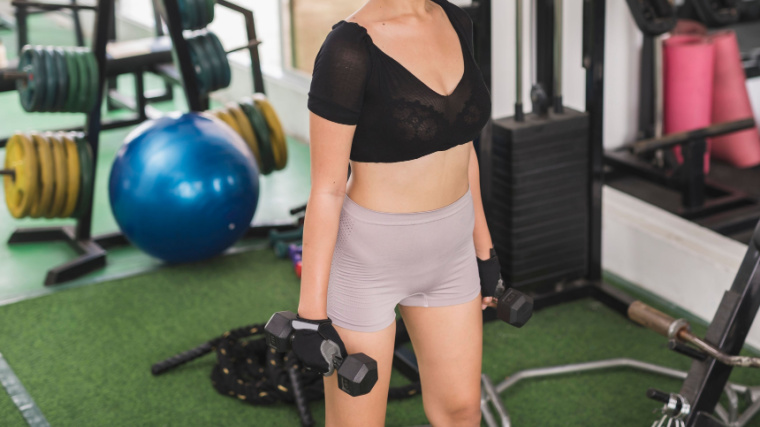
Stand up straight with a dumbbell in each hand, facing your hips with your arms down by your sides. Pull your shoulders down away from your ears, puff your chest up, and firmly grip the weights. Begin with your legs straight but not fully locked out and grip the floor with your feet to create tension in your glutes.
Form Tip: Starting this exercise with good posture is vital. Pinch your shoulder blades together to open your chest and create a neutral spine. Stand “tall” looking straight ahead.
Step 2 — Control the Descent
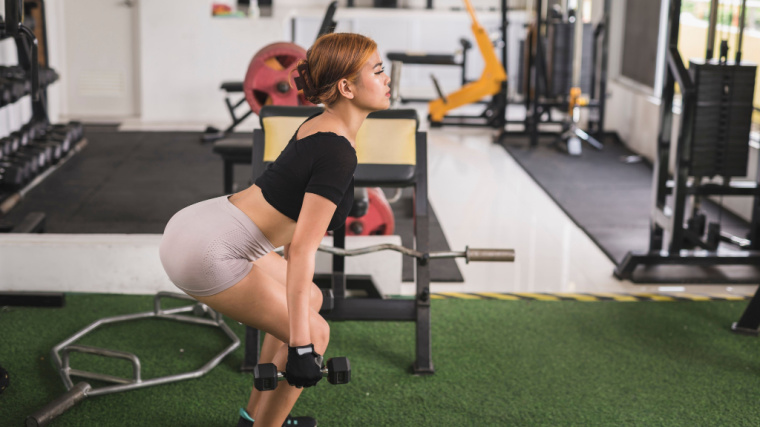
Push your glutes toward the wall behind you and hinge at your hips. Keep your arms straight and allow the weights to “slide” alongside your legs. Keep your shoulders back and down — don’t allow the weights to pull your arms out of position.
Focus on feeling your hamstrings stretch as you lower the weights. As the weights approach your knees, bend your legs to reach a lower position. Don’t force your way to the bottom or sacrifice form, but if you can touch the weights to the ground without losing your posture, that’s an excellent goal.
Form Tip: The barbell deadlift has no significant eccentric contraction (lowering phase), but the dumbbell deadlift is all about the eccentric. Feeling tension in your hamstrings is critical because, if you are not, it means the movement isn’t coming from the target muscles.
Step 3 — Pull and Lockout
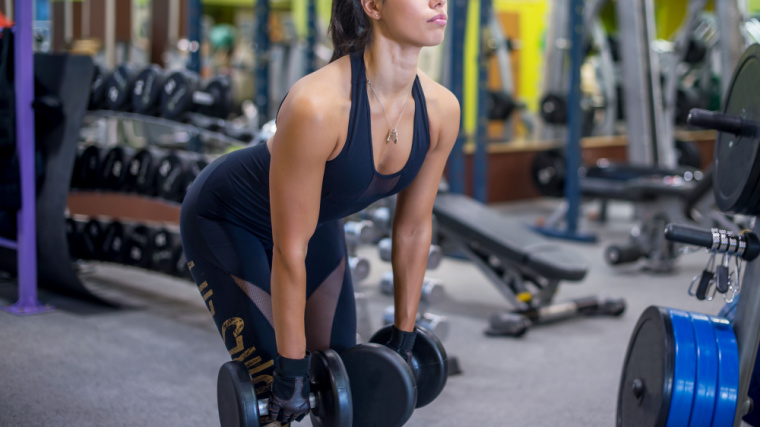
Push your feet through the floor to reverse the movement. Drive your hips forward and keep your shoulders pulled back to “un-hinge.” Ensure you finish at the top by squeezing your glutes, not your lower back. The dumbbells should remain near the sides of your legs throughout the repetition.
Form Tip: When returning upright, avoid simply “standing up” like a squat. Imagine squeezing your armpits together to ensure a neutral spine and to prevent your hips from shooting up too quickly.
Dumbbell Deadlift Mistakes to Avoid
The main thing to remember with the dumbbell deadlift is performing a hinge, not a squat. This requires using your glutes and hamstrings as intended, and keeping your body in the proper position. Lifting out of position creates most problems.
Squatting the Weight
There is nothing “wrong” with doing a dumbbell squat, unless you actually intended to do a dumbbell deadlift and performed a squat accidentally. You end up changing the exercise focus and not achieving your goal.
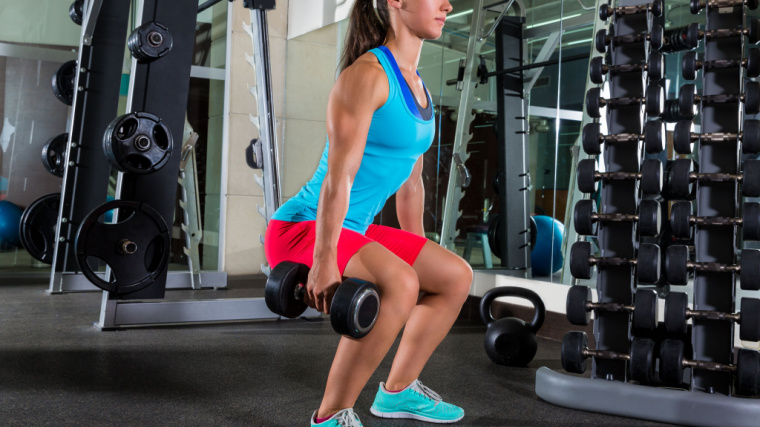
Some lifters tend to move the weight by squatting with a deep knee bend and an upright torso. Instead, you should be hinging at the hips and getting your torso nearly parallel to the ground while keeping their knees only slightly bent. When the dumbbell deadlift is performed correctly, it’s a glute and hamstring exercise. When it’s performed incorrectly, with a squat, it becomes an exercise for the quadriceps.
Avoid it: Pay attention to the muscles you feel stretching and contracting during each repetition. Your hamstrings and glutes should be doing much more work than the quads on the front of your thighs. Performing this exercise sideways to a mirror, or recording a video of your training, may also help you determine whether you’re squatting and not hinging.
Losing Tension
Maintaining muscular tension is the key with most strength exercises, and the dumbbell deadlift is no different. Keeping your upper back engaged, maintaining a neutral spine, and feeling your feet screwed into the floor are keys to a properly performed dumbbell deadlift.
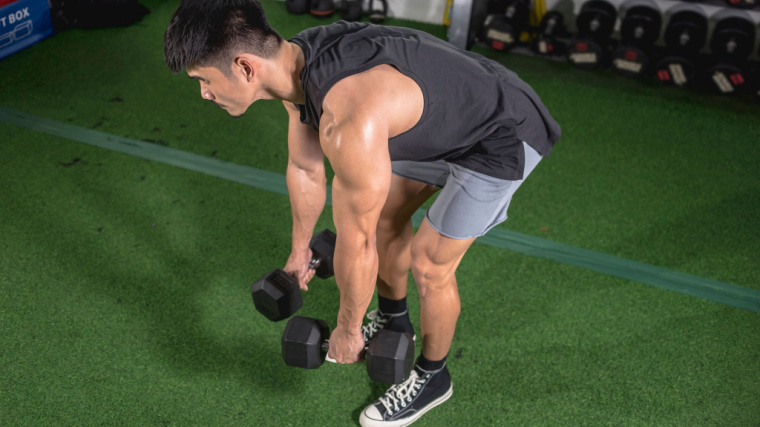
As you lower and lift the weight, the entire back side of your body should feel tense — from your feet up through your hamstrings and glutes, to your abs, lower back, and shoulders.
Avoid it: Squeeze your arms to your sides, like you’re bringing your armpits together through your body. This will engage your upper back and lats, which helps to keep your upper body in a strong position. Trying to grip the floor with your feet, even when you’re wearing shoes, will also help to provide a stable base with good total-body position.
How to Progress the Dumbbell Deadlift
The key to the dumbbell deadlift and most other strength exercises is adding more muscle-building tension and providing progressive overload (gradually challenging yourself by doing more work). Here are a few ways to progress other than adding weight or doing extra reps.
Bodyweight Hip Hinge
If you have yet to master the hinge movement, go back to bodyweight training before adding the dumbbell deadlift. Using a wall as a reference point is a good way to learn how to lead with your hips.
This simple-looking drill will help teach your body the difference between a true hinge movement and a squat. Focus on pushing your hips back and keeping your hands sliding along your legs while keeping your spine stiff.
Tempo Dumbbell Deadlift
Every repetition of an exercise has four components: the eccentric or lowering portion, the stretched position, the concentric or lifting portion, and the lockout. Manipulating how long each component takes is called tempo lifting, and it can be an effective training method when the dumbbells at your gym only go so high.
For example, perform a dumbbell deadlift with a 4-3-3-1 tempo. You take four seconds to lower the weight, hold the bottom position for a three-second pause, take three seconds to stand upright, and pause for one second. This puts your glutes and hamstrings through a longer time under tension which can increase muscle growth. (1)
Single-Arm Suitcase Deadlift
Holding the weight in one hand does two things. First, you must train each side independently, which means more opportunities to strengthen any imbalances between sides and, hopefully, add more overall muscle and strength.
Second, you add an anti-rotation, anti-lateral flexion component to the exercise because the single-sided load with try to pull, rotate, and shift your core toward the weight. Resisting this pull and maintaining a stable torso can improve core stability and strength.
B-Stance Dumbbell Deadlift
Single-leg deadlifts are challenging because you must have great balance to perform them well. Enter the B-stance dumbbell deadlift, which helps your stability and balance while still putting more focus on the front working leg.
This modified stance delivers all the benefits of a single-leg deadlift without having to worry about losing your balance. Focusing the work on each leg separately will also help to address any strength or muscle discrepancies between sides.
Benefits of the Dumbbell Deadlift
The dumbbell deadlift can deliver some big benefits when the exercise is performed as a consistent part of your training program. Here are some reasons to grab the dumbbells instead of the barbell.
Better Hinge Technique
The dumbbell deadlift helps develop the hinge technique using relatively lighter weights because some lifters struggle to maintain a neutral spine once the load gets heavy. Dumbbell deadlifts can make you more aware of any form deviations, like when the dumbbells’ path may change.
The dumbbells act independently as opposed to the barbell deadlift, which keeps you more aware of your body’s position throughout the lift. This develops better total-body awareness and control.
Increased Upper Back Engagement
The dumbbell deadlift requires rock-solid upper back strength because the dumbbells can swing and cause you to lose position. Locking in your upper back and shoulder muscles can prevent this.
The dumbbell position, with a neutral-grip alongside your legs, can make you aware of your shoulder and back position compared to a barbell. Ultimately, this leads to a stronger back and better, safer deadlift technique.
Better Grip Strength
Performing dumbbell deadlifts, especially for higher reps, can deliver gains in grip strength. Your grip strength is challenged by holding onto individual dumbbells, rather than so your stronger hand can’t pick up the slack to perform each rep.
Decreased Joint Strain
Holding dumbbells with a neutral-grip at your sides, instead of holding a barbell with a palm-down grip in front of your body, puts your shoulders and upper body in a more stabilized position.
This decreases the strain on your lower back by reducing the compression and shearing forces. This is a similar benefit of the trap bar deadlift, but can be accomplished much easier with dumbbells since not all gyms provide a trap bar.
Muscles Worked by the Dumbbell Deadlift
There is almost no a muscle untouched when performing the deadlift movement, but there are a few primary muscles emphasized with the dumbbell deadlift in particular.
Hamstrings
The hamstrings assist your glutes with hip extension (straightening your legs and standing up straight) during the lifting and lockout portion of the dumbbell deadlift, and their eccentric strength allows you to control the weight’s descent. Feeling your hamstrings stretch and contract is the exact feedback needed to know you are performing the exercise correctly.
Glutes
Your glutes are primarily responsible for extending your hips during the deadlift, bringing your lower body straight in-line with your upper body. They significantly engage and contract during in the upper portion of the movement, as you approach a complete lockout.
The glutes work together with the hamstrings, and the upper and lower back, to ensure good hip hinge technique. Driving your hips back and “pushing” them through are important steps for activating the glutes.
Upper Back
Your upper back — which includes the rhomboids, trapezius, and parts of the latissimus dorsi, among other smaller muscles — is trained almost as a single unit while performing the dumbbell deadlift.
The primary function of the upper back is to keep a safe and strong neutral spine by maintaining a stable thoracic position. The upper back also helps to control your shoulder blades and keeps them pulled back when controlling the weight.
Lower Back
The erector spinae, a.k.a. “the lower back,” is actually a long column of muscles along the full length of your back. This powerful muscles works together with your glutes, hamstrings, and upper back for strength and stability during the dumbbell deadlift.
The lower back muscles’ primary responsibility is stabilizing your spine, supporting torso, and resisting spinal flexion (bending) under load. If you deadlift with a rounded back, you limit the strength and stability of these important muscles and expose them to significant (and potentially dangerous) direct stress.
How to Program the Dumbbell Deadlift
How you program the dumbbell deadlift depends on your actual goal. Below are some goal-specific set and rep schemes to incorporate the movement into your training program.
To Improve Hinge Technique and Deadlift Form
When you want to improve your deadlift form, it pays to spend more time drilling the hinge position. With its reduced load compared to the barbell, the dumbbell deadlift is helpful for beginners looking to improve general technique and strength the movement-related muscles. Perform three to five sets of six to 10 repetitions, using a controlled eccentric and focusing on good posture.
For Hypertrophy
Because it’s not well-suited to moving hundreds of pounds, the dumbbell deadlift is best used to build muscle size. This exercise can be performed for more reps and, potentially, through a longer range of motion than a barbell because the diameter of the dumbbells is smaller than barbell weight plates.
Increased training volume and a greater range of motion leads to more time under tension for hypertrophy gains. Start by performing three to four sets of eight to 16 reps, using a moderate-to-heavy weight and taking each set close to technical failure — the point at which you can’t perform another rep with good form, as opposed to muscular failure when the target muscles cannot control the weight.
For Muscular Endurance
To improve muscular endurance in the legs, back, and core, training in the higher rep ranges for fewer sets and shorter rest periods is the name of the game. Two to three sets of 15-20 repetitions with less than one minute between sets will have you feeling the burn.
Dumbbell Deadlift Variations
Adding variety to your training keeps you more engaged, reduces the likelihood of picking up an overuse injury, and gives you ways to progress when you can no longer increase the load. These three variations of the dumbbell deadlift will keep you guessing and progressing.
Single-Leg Dumbbell Deadlift
The single-leg dumbbell deadlift is one of the more challenging leg exercises, requiring total-body strength, stability, and coordination. If, or when, you can perform these with good form, you can end up with performance benefits ranging from addressed muscle imbalances, better balance, and improved glute hypertrophy. (2)
You may need to work on B-stance dumbbell deadlifts, explained above, as an intermediary step toward this difficult exercises. The time and effort is well worth it.
Dumbbell Sumo Deadlift
The dumbbell sumo deadlift is a wide-stance deadlift that focuses a little more on your quadriceps, along with your glutes and hamstrings, and without as much lower back stress because you are not as bent-over or hinged forward compared to other deadlifts.
The movement can be performed with a dumbbell in each hand or holding a single dumbbell with both hands.
Dumbbell Stiff-Legged Deadlift
The dumbbell stiff-leg deadlift minimizes knee flexion and focuses almost entirely on hip flexion to put the hamstring and glutes under a little more tension. This is an ideal exercise for lifters looking to emphasize the back halves of their legs.
This simple variation is also effective for lifters who have “outgrown” the dumbbell deadlift in terms of potential load but want to keep progressing.
FAQs
This is a matter of personal preference, as both grips offer different benefits. Holding the dumbbells at your front, like a conventional barbell deadlift, forces you to stay over the load longer while minimizing knee flexion. But this is tougher on your grip and it works your core and lower back a bit more.
With the dumbbells by your sides, your upper back position is more neutral, allowing you to train the lats differently. Plus, holding the dumbbells with a neutral grip is a stronger mechanical position and may allow you to eke out a few more reps before forearm fatigue.
There is no hard and fast rule for depth. Range of motion depends on your hip mobility, the range with which you can maintain muscle control, and your general level of workout experience.
If your goal is hypertrophy, try to get as low as you can control without sacrificing form. This will increase the time under tension on the muscles. If your priority is building strength, use an effective range of motion that balances moving the most weight with the longest range of motion possible.
References
- Burd, N. A., et al. Muscle time under tension during resistance exercise stimulates differential muscle protein sub-fractional synthetic responses in men. The Journal of Physiology, 590(Pt 2), 351-362. https://ift.tt/04OxhBU
- Diamant, W., Geisler, S., Havers, T., & Knicker, A. (2021). Comparison of EMG Activity between Single-Leg Deadlift and Conventional Bilateral Deadlift in Trained Amateur Athletes – An Empirical Analysis. International journal of exercise science, 14(1), 187–201.
Featured Image: YAKOBCHUK VIACHESLAV / Shutterstock
The post How to Do the Dumbbell Deadlift for Size and Strength appeared first on Breaking Muscle.
from Breaking Muscle https://ift.tt/TO13uhj
via IFTTT
